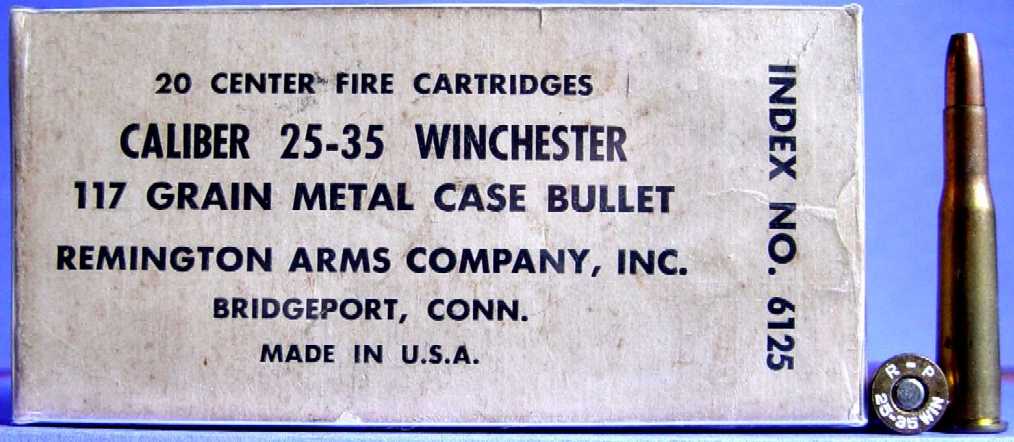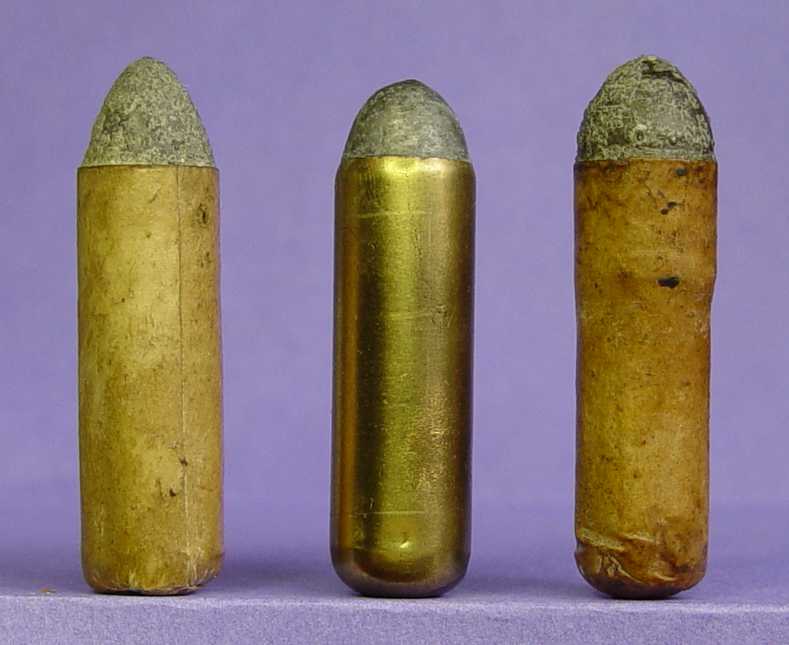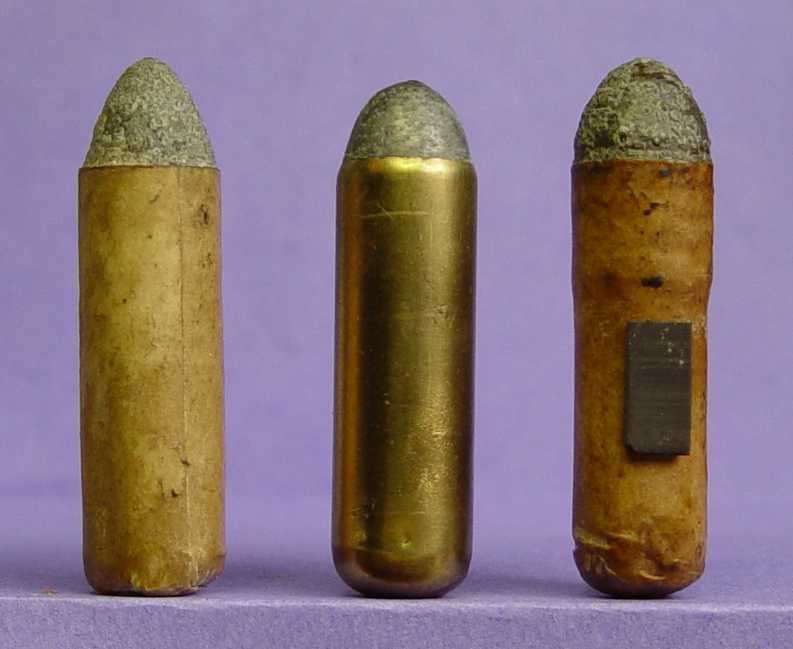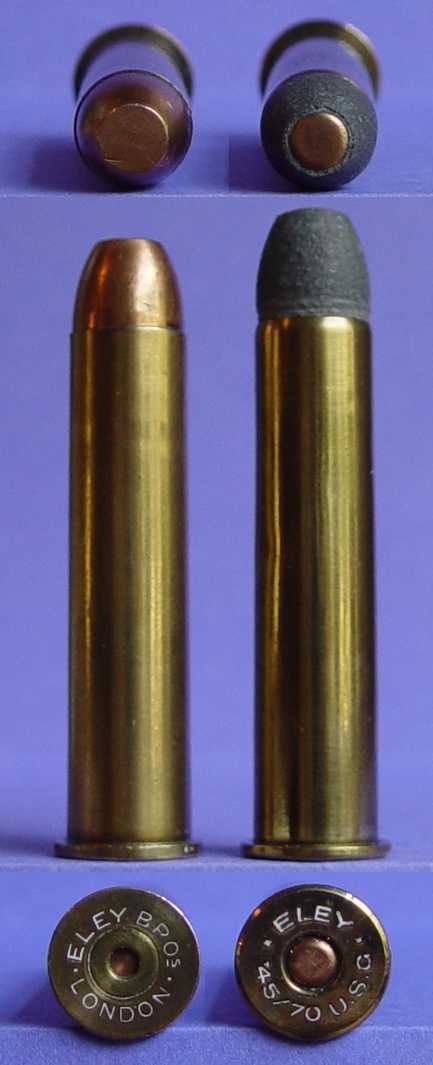| Contents
Home
General
Info
Ordering
Info
Contact us
Cartridge
Lists
Patent & Miscellaneous
Rimfire
Centerfire Pistol
Centerfire Rifle
Metric Rimfire & Centerfire
British
Shotgun Shells
Posters
Cartridge Box
Labels
This Month's Picture Page
Prior Picture Pages:
*
September 2003
*
October 2003
*
November 2003
*
December 2003
*
January 2004
*
February 2004
*
March 2004
*
April 2004
*
May 2004
*
June 2004
*
July 2004
*
August 2004
*
September 2004
*
October 2004
*
November 2004
Links to Other Sites
Cartridge Collectors Organizations:
IAA
ECRA
SAAACA
Auctions:
Auction
Arms
E-Bay
Ward's Collectibles
Sold USA
Books:
Armory
Publications
WCF Publications
Other Collector's Sites:
Curtis Steinhauer
|
Home of the Old Ammo Guy's Virtual
Cartridge Trading Table
Featuring a wide range of antique,
obsolete, and modern ammunition for collectors
Picture
Page
December 2004
A Florida Panhandle fisherman's friend.....
 I'd
like to know who this generic box of .25-35 WCF with the 117 grain full metal
jacket was made for. I had heard that they may have been made for use in
the Florida prison system, but have seen nothing in print to substantiate
this. The full metal jacketed loads apparently had a reputation at some time here in the Big Bend
of Florida as excellent fishing cartridges, but they are just too dadburned hard to find. I get more requests for these
than any other cartridge at our local Tallahassee gun show. Usually, with a
little prodding, I can get the 'lever-action angler" to fess up that he's
looking for these things to restock his tackle box with. I'd
like to know who this generic box of .25-35 WCF with the 117 grain full metal
jacket was made for. I had heard that they may have been made for use in
the Florida prison system, but have seen nothing in print to substantiate
this. The full metal jacketed loads apparently had a reputation at some time here in the Big Bend
of Florida as excellent fishing cartridges, but they are just too dadburned hard to find. I get more requests for these
than any other cartridge at our local Tallahassee gun show. Usually, with a
little prodding, I can get the 'lever-action angler" to fess up that he's
looking for these things to restock his tackle box with.
Several variations of the .50 Gallager...........

Here are three variations of cartridges for the .50 Gallager percussion
carbine, which was used extensively in the Civil War.
The first example is the most common, constructed of thin sheet brass coiled
to form the case. The base is folded in to form a rounded donut-shaped head,
with a small hole in the center through which the fire from a percussion cap
enters to ignite the powder charge. The case is wrapped in a white paper
cover. Over 8 million of these cartridges were produced for use by the Union
cavalry during the war. The cartridge case construction process was covered
under the Rodman & Crispin patent of December 15, 1863, which covered a
"shell of wrapped sheet metal, with the base crimped in and reinforced'.
Another equally common Civil War cartridge, the .50 Smith, used this same
case construction. Cartridges were still being made under this patent nearly
a decade later, as evidenced by .50-70 Rodman-Crispin centerfire made in
limited numbers at the Frankford Arsenal. The second example in the picture
has a solid case, made from a single piece of brass that has been drawn to
shape, forming the tube and donut-shaped base with its central ignition
hole. This is an uncommon type, but is even less common when found with tin
plating on the brass. The last example is constructed very much like the
first, but its case is
 made
of thin sheet steel rather than brass, coiled and shaped in the same manner,
and covered with a tan paper wrapper. Note the differences in the profiles
of the three bullets, the first being more pointed. If it wasn't enough for
me to get these three cartridges to stand up on their rounded bases and
cooperate for the first picture, here's another shot in which the third
cartridge demonstrates how a magnet will stick to the side of it's coiled steel
case. made
of thin sheet steel rather than brass, coiled and shaped in the same manner,
and covered with a tan paper wrapper. Note the differences in the profiles
of the three bullets, the first being more pointed. If it wasn't enough for
me to get these three cartridges to stand up on their rounded bases and
cooperate for the first picture, here's another shot in which the third
cartridge demonstrates how a magnet will stick to the side of it's coiled steel
case.
A couple of British .45-70
cartridges..........
 These
two cartridges are in a common caliber, but exhibit headstamps and
non-standard options that are pretty hard to find, at least on this side of
the Atlantic. Both were made by Eley Brothers of London, England. The first
one, with its full metal cased bullet, has what on first glance appears to
be a Winchester-style protected primer, but the opening in
the center of the primer is .049" deep. I measured the depth of this opening
on a Winchester protected primer at .020".
The second cartridge is fitted with an 'express' bullet, having
a copper tube inserted into its hollow nose to aid in expansion of the lead.
Its headstamp is a little unusual, the slash between the '45' and '70'
lending a seemingly modern look to a cartridge that was probably made before
1900. These
two cartridges are in a common caliber, but exhibit headstamps and
non-standard options that are pretty hard to find, at least on this side of
the Atlantic. Both were made by Eley Brothers of London, England. The first
one, with its full metal cased bullet, has what on first glance appears to
be a Winchester-style protected primer, but the opening in
the center of the primer is .049" deep. I measured the depth of this opening
on a Winchester protected primer at .020".
The second cartridge is fitted with an 'express' bullet, having
a copper tube inserted into its hollow nose to aid in expansion of the lead.
Its headstamp is a little unusual, the slash between the '45' and '70'
lending a seemingly modern look to a cartridge that was probably made before
1900.
.
|

 I'd
like to know who this generic box of .25-35 WCF with the 117 grain full metal
jacket was made for. I had heard that they may have been made for use in
the Florida prison system, but have seen nothing in print to substantiate
this. The full metal jacketed loads apparently had a reputation at some time here in the Big Bend
of Florida as excellent fishing cartridges, but they are just too dadburned hard to find. I get more requests for these
than any other cartridge at our local Tallahassee gun show. Usually, with a
little prodding, I can get the 'lever-action angler" to fess up that he's
looking for these things to restock his tackle box with.
I'd
like to know who this generic box of .25-35 WCF with the 117 grain full metal
jacket was made for. I had heard that they may have been made for use in
the Florida prison system, but have seen nothing in print to substantiate
this. The full metal jacketed loads apparently had a reputation at some time here in the Big Bend
of Florida as excellent fishing cartridges, but they are just too dadburned hard to find. I get more requests for these
than any other cartridge at our local Tallahassee gun show. Usually, with a
little prodding, I can get the 'lever-action angler" to fess up that he's
looking for these things to restock his tackle box with.
 made
of thin sheet steel rather than brass, coiled and shaped in the same manner,
and covered with a tan paper wrapper. Note the differences in the profiles
of the three bullets, the first being more pointed. If it wasn't enough for
me to get these three cartridges to stand up on their rounded bases and
cooperate for the first picture, here's another shot in which the third
cartridge demonstrates how a magnet will stick to the side of it's coiled steel
case.
made
of thin sheet steel rather than brass, coiled and shaped in the same manner,
and covered with a tan paper wrapper. Note the differences in the profiles
of the three bullets, the first being more pointed. If it wasn't enough for
me to get these three cartridges to stand up on their rounded bases and
cooperate for the first picture, here's another shot in which the third
cartridge demonstrates how a magnet will stick to the side of it's coiled steel
case.
 These
two cartridges are in a common caliber, but exhibit headstamps and
non-standard options that are pretty hard to find, at least on this side of
the Atlantic. Both were made by Eley Brothers of London, England. The first
one, with its full metal cased bullet, has what on first glance appears to
be a Winchester-style protected primer, but the opening in
the center of the primer is .049" deep. I measured the depth of this opening
on a Winchester protected primer at .020".
The second cartridge is fitted with an 'express' bullet, having
a copper tube inserted into its hollow nose to aid in expansion of the lead.
Its headstamp is a little unusual, the slash between the '45' and '70'
lending a seemingly modern look to a cartridge that was probably made before
1900.
These
two cartridges are in a common caliber, but exhibit headstamps and
non-standard options that are pretty hard to find, at least on this side of
the Atlantic. Both were made by Eley Brothers of London, England. The first
one, with its full metal cased bullet, has what on first glance appears to
be a Winchester-style protected primer, but the opening in
the center of the primer is .049" deep. I measured the depth of this opening
on a Winchester protected primer at .020".
The second cartridge is fitted with an 'express' bullet, having
a copper tube inserted into its hollow nose to aid in expansion of the lead.
Its headstamp is a little unusual, the slash between the '45' and '70'
lending a seemingly modern look to a cartridge that was probably made before
1900.